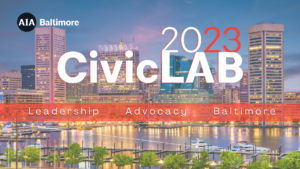Baltimore, MD (June 29, 2017) – This week, AIABaltimore sent a letter to Councilman Ryan Dorsey (District 3) endorsing the Complete Streets legislation soon to be introduced to Baltimore City Council. The legislation will require the Department of Transportation (DOT) to adopt comprehensive design guidelines that combine street design, placemaking, and community vision, and require DOT to apply complete streets principles each time it undertakes resurfacing or other street projects.
Below is the letter sent to Councilman Dorsey prepared by the AIABaltimore Committee on the Environment and Resiliency (COTE | R):
Dear Councilman Ryan Dorsey:
I am writing to you on behalf of the Baltimore Chapter of the American Institute of Architects (AIABaltimore) and our 1,300 members representing architects, design professionals, and allied organizations in related engineering and construction fields to endorse the Complete Streets bill you are introducing to the Baltimore City Council. Streets comprise a significant percentage of city-owned land, offering a unique opportunity to incorporate elements that will not only make our streets safer, but protect the environment, improve community health and promote prosperity.
As architects, we know the tremendous value and benefits of an integrated design process that brings together people and place in the planning, design, construction, operation, and maintenance of our transportation networks. By looking at streets holistically with a complete streets policy in place, design can be cost effective, provide added value and avoid expensive changes after construction has finished. Complete streets also ensure that streets are safe for people of all ages and abilities, balance the needs of different modes of transportation, and support local land uses, economies, cultures, and natural environments.
Equity is integral to complete streets. Everyone deserves safe, comfortable, and convenient access to community destinations and public places. The Complete Streets bill ensures that investment is prioritized in neighborhoods where the majority of residents lack vehicle access, where persons of color represent the majority, and where median household income is below city average. A network of connected facilities that improve mobility and quality of life for all will create safer streets for children, improve access to jobs, and transform the street into an extension of the community.
In addition to reducing reliance on cars, complete streets benefit the environment by addressing issues such as stormwater management and urban heat island mitigation. Applied citywide, landscaping elements that help curb stormwater runoff are mutually beneficial for mobility and ecology. When redesigning streets, project managers can include plants and trees to clean runoff and manage stormwater onsite. Traffic calming elements like chicanes, islands, and curb extensions provide opportunities for bioswales, street trees, and rain gardens. Trees provide shade, oxygen, reduce CO2 levels, and beautify the streetscape for residents. Such green elements are increasingly found to be important deterrents of crashes and injuries, and contribute to a more comfortable and visually interesting environment for all users.
The Complete Streets bill will complement many current City initiatives, including:
- Green Network
- Bike sharing
- Climate Action Plan
- Bike lane network expansion
- Green Building Code
- Transform Baltimore
The Complete Streets bill is an opportunity for Baltimore to lead the way in best urban design practices. It will be a leap forward towards an interconnected city that promotes equity, prosperity, public health, safety, and overall livability.
If you or your staff requires additional information or has questions, please do not hesitate to contact AIABaltimore: Kathleen Lane, Executive Director, 410-625-2585 x 101, klane@aiabalt.com.
We thank you for your consideration.
Sincerely,

Sharon Day, AIA, President

